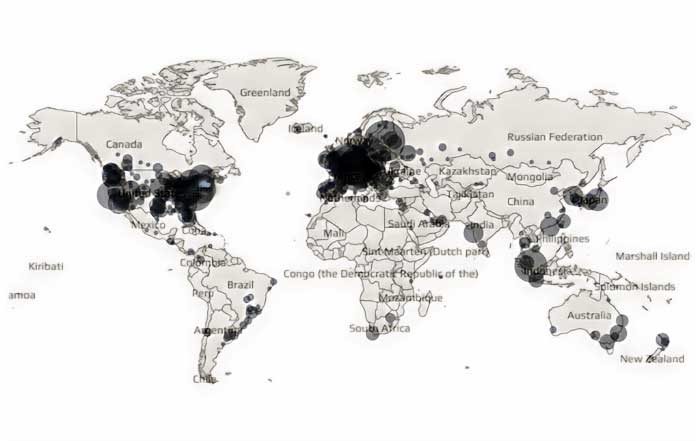Over the past few decades, China's transformation from a primarily manufacturing-based economy to a burgeoning technological powerhouse has captured the attention of the global community. This metamorphosis has not only reshaped the country's economic landscape but has also given rise to a cohort of tech behemoths that rival, and in some areas surpass, their Western counterparts. Companies such as Alibaba, Tencent, Baidu, Huawei, Xiaomi, ByteDance, JD.com, and Didi Chuxing have emerged as formidable players in the global market, driving innovation across various sectors including e-commerce, social media, artificial intelligence, telecommunications, and more. The ascent of these corporations reflects not only China's domestic ambitions but also its growing influence on the international stage, prompting discussions about competition, regulation, and the future of technology worldwide.
Founded in 1999 by Jack Ma, a former English teacher, Alibaba Group began as an online marketplace aimed at connecting Chinese manufacturers with overseas buyers. The company's inception was rooted in the vision of leveraging the internet to level the playing field for small and medium-sized enterprises, enabling them to compete on a global scale. Over the years, Alibaba expanded its portfolio to include a suite of e-commerce platforms such as Taobao, Tmall, and AliExpress, catering to both consumer-to-consumer and business-to-consumer markets. These platforms revolutionized the retail landscape in China by providing a vast digital marketplace where millions of products became accessible to consumers nationwide.
In addition to its dominance in e-commerce, Alibaba ventured into cloud computing with the establishment of Alibaba Cloud in 2009. This move positioned the company as a key player in the cloud services sector, offering scalable computing resources, data storage, and advanced analytics to businesses of all sizes. Alibaba Cloud's growth mirrored the global surge in demand for cloud infrastructure, and it quickly became one of the largest cloud service providers in the Asia-Pacific region.
Alibaba also made significant strides in digital finance through Ant Group, originally known as Alipay. Launched as a payment platform to facilitate transactions on Alibaba's e-commerce sites, Alipay evolved into a comprehensive financial services provider, offering wealth management, insurance, and credit services. Ant Group's innovative use of technology in finance democratized access to financial services for millions in China, though it also attracted regulatory scrutiny leading to a halted initial public offering in 2020.
Globally, Alibaba has sought to expand its footprint by investing in international ventures and promoting cross-border trade. Initiatives like the Electronic World Trade Platform aim to lower trade barriers for small businesses worldwide. However, the company faces challenges such as increasing regulatory pressures at home, intensifying competition, and geopolitical tensions that impact its international operations.
Tencent Holdings, established in 1998 by Ma Huateng and his associates, began its journey with the launch of QQ, an instant messaging service that quickly gained popularity in China. Recognizing the potential of digital communication, Tencent expanded into various internet-related services, solidifying its position in the social media sphere. The introduction of WeChat in 2011 marked a pivotal moment for the company. WeChat evolved beyond messaging to become a multifaceted platform integrating social networking, mobile payments, gaming, and a host of mini-programs that allowed users to perform numerous tasks within a single app.
WeChat's ubiquity in China cannot be overstated; it has become an integral part of daily life for over a billion users, facilitating communication, commerce, and entertainment. Tencent leveraged this massive user base to dominate the online gaming industry, both domestically and internationally. The company owns or holds significant stakes in numerous game developers, including Riot Games, Epic Games, and Supercell, contributing to a diversified portfolio that spans across various gaming genres and platforms.
Beyond social media and gaming, Tencent has ventured into fintech through WeChat Pay, competing directly with Alipay in the mobile payments arena. The seamless integration of WeChat Pay into the WeChat ecosystem allowed users to conduct transactions effortlessly, further entrenching Tencent's influence in the digital economy. The company also expanded into cloud computing, artificial intelligence, and content creation, investing heavily in music streaming, video platforms, and literature.
Internationally, Tencent's strategy has involved significant investments in global tech companies, fostering partnerships and acquiring stakes that extend its reach beyond China's borders. Despite its successes, Tencent faces challenges including regulatory hurdles, especially concerning data privacy and antitrust issues, as well as the complexities of operating in different geopolitical environments.
Often referred to as "China's Google," Baidu was founded in 2000 by Robin Li and Eric Xu. It quickly established itself as the leading search engine in China, capitalizing on the country's rapidly growing internet user base. Baidu's search services became the backbone of China's internet ecosystem, offering users access to a wide range of information and services.
Recognizing the importance of technological innovation, Baidu invested heavily in artificial intelligence research and development. The company established the Baidu Research Institute, focusing on AI disciplines such as deep learning, natural language processing, and computer vision. Baidu's advancements in AI have been applied to various products and services, including voice recognition technology used in its DuerOS platform and autonomous driving initiatives under the Apollo project.
The Apollo project, launched in 2017, aimed to create an open-source platform for autonomous vehicles, partnering with automotive manufacturers, suppliers, and other tech companies. Baidu's vision for the future of transportation involves leveraging AI to develop safer, more efficient self-driving cars, contributing to the global push towards autonomous mobility.
Despite its technological prowess, Baidu has faced stiff competition from other Chinese tech companies expanding into search and AI, as well as challenges in monetizing its services in the face of changing user behaviors. The company continues to adapt by diversifying its offerings and seeking new growth areas in emerging technologies.
Founded in 1987 by Ren Zhengfei, a former engineer in the People's Liberation Army, Huawei began as a manufacturer of telephone exchange switches. Over the years, it expanded into producing telecommunications equipment, eventually becoming the world's largest supplier in this sector. Huawei's products and solutions span across network infrastructure, enterprise solutions, consumer devices, and cloud services.
One of Huawei's significant achievements is its leadership in 5G technology. The company's investment in research and development enabled it to pioneer advancements in 5G infrastructure, offering equipment that was both technologically advanced and cost-competitive. This positioned Huawei as a preferred supplier for many countries looking to upgrade their telecommunications networks.
However, Huawei's global ambitions have been hampered by geopolitical tensions, particularly with the United States. Concerns over national security and allegations of intellectual property theft led to sanctions and restrictions, limiting Huawei's access to critical technology such as semiconductor chips and software. These challenges have forced the company to pivot its strategies, focusing more on the domestic market and exploring new areas like cloud computing and smart vehicles.
Despite these hurdles, Huawei remains a significant player in the tech industry, leveraging its extensive expertise in telecommunications and commitment to innovation. The company's future endeavors aim to navigate the complex global landscape while continuing to contribute to technological advancements.
Xiaomi, established in 2010 by Lei Jun and his partners, entered the smartphone market with a focus on providing high-quality devices at affordable prices. The company's business model centered around thin profit margins on hardware, with the intention of generating revenue through software and services. Xiaomi's strategy resonated with consumers seeking value for money, propelling the company to become one of the top smartphone manufacturers globally.
Beyond smartphones, Xiaomi expanded into a wide array of consumer electronics and smart home devices, creating an ecosystem interconnected through the Internet of Things (IoT). Products ranging from fitness bands and smart TVs to air purifiers and electric scooters exemplify Xiaomi's diversified portfolio. The company's emphasis on user feedback and community engagement has fostered a loyal customer base.
Internationally, Xiaomi aggressively pursued expansion into markets such as India, Europe, and Southeast Asia. The company's adaptability to local markets and competitive pricing allowed it to gain significant market share outside China. Xiaomi continues to innovate by investing in new technologies and exploring opportunities in electric vehicles and other emerging sectors.
Timeline of China's Tech Giants
1998
Tencent founded, launches QQ
1999
Alibaba founded by Jack Ma
2000
Baidu established
2010
Xiaomi founded
2012
ByteDance and Didi Chuxing launched
Founded in 2012 by Zhang Yiming, ByteDance is best known for creating TikTok (known as Douyin in China), a short-form video platform that has taken the world by storm. TikTok's algorithm-driven content delivery system, which personalizes feeds based on user interactions, has been a key factor in its global success. The platform's appeal spans across demographics, fostering a new wave of content creation and consumption.
ByteDance's influence extends beyond TikTok, with a suite of products including news aggregator Toutiao and various apps focused on education, productivity, and entertainment. The company's rapid growth and innovative use of artificial intelligence have positioned it as one of the most valuable startups globally.
However, ByteDance has faced significant regulatory challenges, particularly concerning data privacy and national security. In several countries, including the United States and India, TikTok has been scrutinized over concerns about user data handling and potential government influence. These issues have led to legal battles, potential bans, and demands for the sale of TikTok's operations in certain regions.
Despite these obstacles, ByteDance continues to expand its offerings and invest in new technologies, seeking to maintain its growth trajectory while navigating the complex regulatory environments of different countries.
JD.com, founded by Richard Liu in 1998, started as a brick-and-mortar store selling optical products before transitioning to an online platform following the SARS epidemic in 2003. The company has since grown into one of China's largest e-commerce platforms, specializing in electronics, appliances, and a wide range of consumer goods.
What sets JD.com apart is its focus on logistics and supply chain management. The company invested heavily in building its own nationwide logistics network, including warehouses, delivery vehicles, and even drones for rural deliveries. This infrastructure enables JD.com to offer fast and reliable delivery services, enhancing customer satisfaction and trust.
JD.com's commitment to authenticity and quality control addresses common concerns about counterfeit goods in China's e-commerce sector. By sourcing products directly from manufacturers and implementing strict verification processes, the company has established a reputation for reliability.
In addition to retail, JD.com has ventured into technology services, cloud computing, and finance, leveraging its data and infrastructure to provide solutions for businesses. The company's strategic partnerships and investments, both domestically and internationally, aim to strengthen its position in the global market.
Didi Chuxing, launched in 2012 by Cheng Wei, rapidly became China's leading ride-hailing platform. The company gained prominence by acquiring Uber's China operations in 2016, effectively consolidating its dominance in the domestic market. Didi offers a range of transportation services, including private car-hailing, taxi-hailing, bike-sharing, and carpooling.
Didi's success is attributed to its understanding of the local market, tailored services, and integration of various modes of transportation within its platform. The company's use of big data and AI enhances route planning, pricing, and safety features, improving the overall user experience.
However, Didi has faced significant regulatory challenges, particularly concerning passenger safety, driver qualifications, and data security. In 2021, following its initial public offering in the United States, Chinese regulators launched investigations into Didi's data practices, leading to the removal of its app from domestic app stores and significant operational restrictions.
These regulatory actions highlight the increasing scrutiny tech companies face in China, especially regarding data handling and compliance with national security laws. Didi is working to address these issues while exploring opportunities in autonomous driving and international markets.
Challenges Facing Chinese Tech Giants
Chinese tech companies operate in a complex environment marked by rapid growth, intense competition, and evolving regulatory landscapes. Domestically, the Chinese government has intensified antitrust enforcement and introduced new regulations aimed at curbing monopolistic practices, ensuring data security, and promoting fair competition. These measures have led to fines, operational adjustments, and increased compliance costs for major tech firms.
On the international front, geopolitical tensions, particularly between China and the United States, have impacted Chinese tech companies' global ambitions. Issues such as trade disputes, technology transfer concerns, and sanctions have restricted access to critical technologies and markets. Companies like Huawei and ByteDance have been at the forefront of these challenges, navigating sanctions and attempting to reassure global partners and consumers of their independence and trustworthiness.
Data privacy and security concerns also pose significant challenges. As tech companies collect vast amounts of user data, governments and users alike demand greater transparency and accountability. Compliance with varying international data protection regulations, such as the European Union's GDPR, adds complexity to global operations.
The Future Outlook
Despite the challenges, Chinese tech giants continue to innovate and expand into new territories. Investment in emerging technologies such as artificial intelligence, quantum computing, biotechnology, and renewable energy positions these companies at the forefront of the next technological revolution. Collaborations with international partners, strategic investments, and a focus on research and development underpin their growth strategies.
Global expansion remains a key objective, though companies are increasingly cautious and strategic in their approach due to geopolitical sensitivities. Diversification into new markets and sectors, such as electric vehicles, smart cities, and healthcare technology, offers opportunities for growth and influence.
The Chinese government's support for technological advancement, as outlined in initiatives like "Made in China 2025" and the "14th Five-Year Plan," provides a conducive environment for innovation. However, companies must balance this support with compliance to regulatory frameworks and social responsibilities.
Wrapping It Up
The rise of China's tech giants reflects the country's rapid economic development and ambition to become a global leader in technology and innovation. Companies like Alibaba, Tencent, Baidu, Huawei, Xiaomi, ByteDance, JD.com, and Didi Chuxing have not only transformed industries within China but have also made significant impacts on the global stage. Their successes are accompanied by challenges that require adaptability, resilience, and strategic foresight.
As these companies navigate regulatory landscapes, geopolitical tensions, and technological disruptions, their ability to innovate and compete will shape not only their own futures but also the global tech ecosystem. The world watches closely as China's tech giants continue to evolve, offering insights into the interplay between technology, economics, and international relations in the 21st century.








